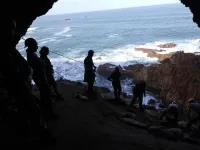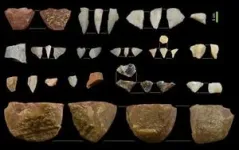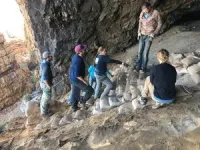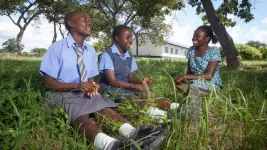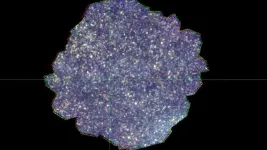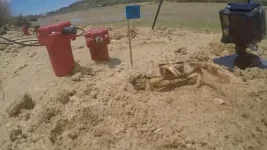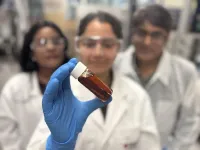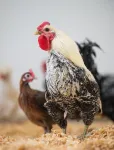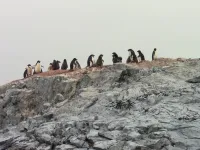(Press-News.org) In a cave overlooking the ocean on the southern coast of South Africa, archaeologists discovered thousands of stone tools, created by ancient humans roughly 20,000 years ago. By examining tiny details in the chipped edges of the blades and stones, archaeologists are able to tell how the tools were made. In a new study published in the Journal of Paleolithic Archaeology, researchers analyzed these stone tools and discussed how the different techniques used to make them hint at the ways that prehistoric people traveled, interacted, and shared their craft.
“This is an important insight into how people who lived in this region were living and hunting and responding to their environment,” says Sara Watson, a postdoctoral scientist at the Field Museum’s Negaunee Integrative Research Center and lead author of the study.
During the period when these blades were made, between 24,000 and 12,000 years ago, the Earth was nearing the end of the last major ice age. Since so much of the Earth’s water was frozen in glaciers and ice caps, the sea level was lower, and the region that’s now the coast of South Africa was a few miles inland. “Instead of being right on the water like they are today, these caves would have been near vast, open plains with large game animals like antelope,” says Watson. “People hunted those animals, and to do that, they developed new tools and weapons.”
The caves, part of what archaeologists call the Robberg technocomplex, no longer overlook a plain— they're in a towering cliff face over a rocky beach. “It’s a 75-foot climb up to the cave from the shoreline,” says Watson. “We had safety ropes and a staircase made of sandbags, and we had to be harnessed in while doing the excavation.”
Every day, Watson and her colleagues made the climb with all their excavation and photography equipment, weighing up to 50 pounds per person. “Since these are extremely, extremely old sites, from before the end of the last ice age, we had to be very careful with our excavation,” says Watson. “We used little tiny dental tools and mini trowels so that we could remove each little individual layer of sediment.”
Beneath ancient dust and dirt, Watson and her team found thousands of stone tools: small, sharp blades, as well as the larger pieces of rock from which these blades were chipped. The bigger rock that blades are made from is called a core. “When your average person thinks about stone tools, they probably focus on the detached pieces, the blades and flakes. But the thing that is the most interesting to me is the core, because it shows us the particular methods and order of operations that people went through in order to make their tools,” says Watson.
Watson and her colleagues observed several distinct patterns of how the cores had been broken into smaller blades. “In a lot of these technologies, the core reduction is very specific, and it’s something that you are taught and learn, and that’s where the social information is,” says Watson. “If we see specific methods of core reduction at multiple sites across the landscape, as an archaeologist, it tells me that these people were sharing ideas with one another.”
For instance, one particular method of breaking tiny bladelets off of a core that Watson found in the Robberg caves is a style also found hundreds of miles away in places including Namibia and Lesotho. “Same core reduction pattern, same intended product,” says Watson. “The pattern is repeated over and over and over again, which indicates that it is intentional and shared, rather than just a chance similarity.”
Overall, Watson says that the study reveals how much there still is to learn about the Robberg caves and the people who used them thousands of years ago. “We have a very long and rich history as a species, and humans go back a lot farther in time than most people realize,” says Watson. “People living around the last ice age were very similar to people today.”
###
END
Ancient tools from a South African cave reveal connections between prehistoric people
2025-04-09
ELSE PRESS RELEASES FROM THIS DATE:
World’s first birth following conception with a fully automated remotely operated ICSI system
2025-04-09
10 April 2025: The world’s first baby has been born following conception with a fully automated, digitally controlled intracytoplasmic sperm injection (ICSI) system. ICSI, developed and adopted into widespread use in the 1990s and now a routine method of assisted conception, achieves fertilisation by injecting a single sperm cell into the centre of a mature egg.
The details are reported today in the peer-review medical journal Reproductive Biomedicine Online.(1) The automated system was described and developed by a multidisciplinary team of specialists from Conceivable ...
Girls’ education projects succeed when whole communities ‘live the change’ and carry it forward
2025-04-09
Education projects supporting marginalised girls in lower-income countries are more likely to achieve lasting transformations when they mobilise young women and their communities as “agents of change”, a new report indicates.
The recommendation comes from the latest evaluation of the Girls’ Education Challenge: a UK Government-supported initiative which has funded projects reaching more than 1.6 million girls. The University of Cambridge-led study finds that these projects initiated “virtuous cycles” of change – particularly by rooting themselves in communities and empowering young women to lead the way.
In ...
European bird declines linked to range of climatic conditions experienced
2025-04-09
New research suggests conservation efforts could more effectively identify and protect bird species at greatest risk from climate change by better understanding the range of specific conditions they need to thrive.
The study, led by the University of East Anglia (UEA), examined the relationship between the extent of the climatic conditions that species tolerate and in which populations can survive - known as climatic niche breadth - and their likelihood of declining in response to climate change.
For species inhabiting a similar area of geographic space, those able to tolerate ...
'Hidden galaxies' could be smoking gun in universe riddle
2025-04-09
Astronomers have peered back in time to find what looks like a population of 'hidden' galaxies that could hold the key to unlocking some of the universe's secrets.
If their existence is confirmed it would "effectively break current models of galaxy numbers and evolution".
The possible galaxies may also provide the missing piece of the puzzle for the energy generation in the universe in infrared light.
That's because their combined light would be enough to top-up the energy budget of the universe to the maximum we observe, effectively ...
Love songs in the sand: researchers listen in to Fiddler crab courtship
2025-04-09
UNDER EMBARGO UNTIL 00:01 BST THURSDAY 10 APRIL / 19:01 ET WEDNESDAY 9 APRIL 2025
For the first time, a study led by University of Oxford researchers has ‘listened in’ to the fascinating courtship displays of Fiddler crabs using geophones. The findings, published today in the Journal of Experimental Biology, provide new insights into how the animals communicate effectively on the noisy seashore.
For male fiddler crabs, vibrational signals are a crucial part of their courtship routines – produced by drumming the ground using their oversized claw, ...
Study suggests lean muscle mass loss can be minimized during weight loss therapy using newer incretin obesity drugs
2025-04-09
New research to be presented at this year’s European Congress on Obesity (ECO 2025, Malaga, Spain, 11-14 May) shows that patients using GLP-1 or combined GLP-1 / GIP receptor agonist therapy for weight loss experienced minimal lean muscle mass loss as they lost weight across 6 months of treatment. The study is by Dr Dinabel Peralta-Reich, Donald and Barbara Zucker School of Medicine at Hofstra/Northwell; Lenox Hill Hospital, Northwell Health, New York City, NY, USA, and Dr Alexandra Filingeri, New York Weight Wellness Medicine, New York City, NY, USA, and colleagues.
GLP-1 (glucagon-like peptide-1) receptor agonists, ...
Aussie tech helps make bio-oils for greener industrial applications
2025-04-09
Australian technology developed at RMIT University could enable more sustainable and cheaper production of bio-oils to replace petroleum-based products in electronic, construction and automotive applications.
The technology, known as PYROCOTM, uses high temperatures without oxygen to convert treated sewage (biosolids) into a carbon-rich product called biochar, which can act as a catalyst to produce phenol-rich bio-oil.
PYROCOTM has been developed by RMIT in collaboration with South East Water, Intelligent Water Networks and other water authorities over several years and is now being applied to several exciting circular economy applications.
The RMIT team's latest research in collaboration ...
Map of genetic regulation in chickens could help fight against bird flu
2025-04-09
An international team of researchers led by Professor Huaijun Zhou from the UC Davis Department of Animal Science has created the first-ever detailed map of how genes are regulated in chickens — a breakthrough that could help scientists breed birds that are more resistant to diseases like avian influenza.
The study, published April 8 in Nature Genetics, brings together a massive amount of genetic and epigenetic data of more than 100 chicken breeds from around the world. The team, which ...
Scientists map unprecedented detail of connections and visual perception in the mouse brain
2025-04-09
What: In a massive scientific effort funded by the National Institutes of Health (NIH), hundreds of researchers have helped to map the connections between hundreds of thousands of neurons in the mouse brain and then overlayed their firing patterns in response to visual stimuli. This breakthrough is a critical piece of foundational science to build toward understanding how our brains process visual information to reconstruct the images we see every day.
Information processing in the human brain occurs ...
Mapping mercury contamination in penguins of the Southern Ocean
2025-04-09
In 1962, when environmentalist and author Rachel Carson penned Silent Spring, alerting the world to the dangers of the pesticide DDT, it was the reproductive threat to birds – the bald eagle in particular – that spurred people to action.
Six decades later, Rutgers University–New Brunswick researchers are taking the measure of another global environmental pollutant by drawing parallels to the crisis Carson identified. This time, the pollutant is mercury, and the sentinels are penguins living in the farthest reaches of the Antarctic Peninsula.
“With mercury, there’s an analogy to DDT,” said John Reinfelder, a professor in the Department of Environmental Sciences ...
